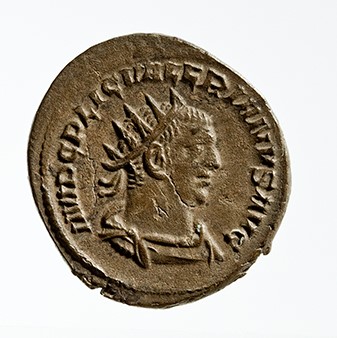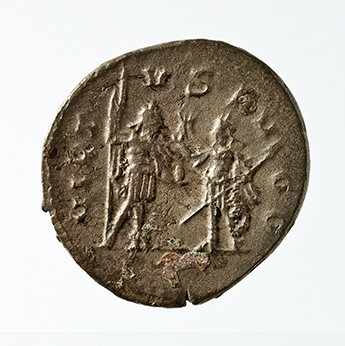Acquisition number: 1966.63
Obv.: Bust of Valerianus r., radiate, draped, bearded. IMP(erator) C(aesar) P(ublius) LIC(inius) VALERIANVS AVG(ustus).
Rev.: The two emperors standing facing each other in military dress, the left one with a spear (sceptre?) in right hand and a globe in the left, the right one with a Victory in right hand and a spear in left. VIRTVS AVGG( = Augustorum).
Title: Antoninianus of Valerian - 1966.63
Acquisition number: 1966.63
Author or editor: Beryl Rawson
Culture or period: Roman Imperial
Date: AD 253-254
Material: Metal - Copper-silver alloy
Object type: Coins - Roman
Dimensions: 22mm (w)
Origin region or location: Türkiye
Origin city: Antioch
Display case or on loan: 7
Keywords: Coin, antoninianus, Roman, Imperial, Valerian, Gallienus, Victory, Syria (Roman province), Antioch, Roman Syria
Mattingly, H., E.A. Sydenham, C.H. Sutherland, R.A. Carson, The Roman Imperial Coinage 13 vols (London, Spink, 1923-1994) V Part 1 293; Robertson, A. Roman Imperial Coins in the Hunter Coin Cabinet, University of Glasgow 5 vols (Oxford: Oxford University Press, 1962-1982) IV 11 no. 76 and pl. 3; Seaby, H.A., Roman Silver Coins (London, B.A. Seaby, 1967) IV 276; see Sear, D.R., Roman Coins and their Values 5 vols (London, Spink, 2000-2014) 9995.
1966.63
Antoninianus of Valerian
3.890 g. AD 253-254
Obv.: Bust of Valerianus r., radiate, draped, bearded. IMP(erator) C(aesar) P(ublius) LIC(inius) VALERIANVS AVG(ustus).
Rev.: The two emperors standing facing each other in military dress, the left one with a spear (sceptre?) in right hand and a globe in the left, the right one with a Victory in right hand and a spear in left. VIRTVS AVGG( = Augustorum).
Valerian became emperor in AD 253 after a bout of civil war, and made his son Gallienus fellow emperor. Hence the plural‘AVGG. ’ on the reverse: ‘virtue/valour of the emperors’. Valerian took responsibility for the Eastern frontier, and this coin was probably struck at the mint in Antioch. He was captured by the Persians in AD 259 and died in captivity in 260.
The long obverse legend is characteristic of earlier coins of the reign.
Mattingly, H., E.A. Sydenham, C.H. Sutherland, R.A. Carson, The Roman Imperial Coinage 13 vols (London, Spink, 1923-1994) V Part 1 293; Robertson, A. Roman Imperial Coins in the Hunter Coin Cabinet, University of Glasgow 5 vols (Oxford: Oxford University Press, 1962-1982) IV 11 no. 76 and pl. 3; Seaby, H.A., Roman Silver Coins (London, B.A. Seaby, 1967) IV 276; see Sear, D.R., Roman Coins and their Values 5 vols (London, Spink, 2000-2014) 9995.

